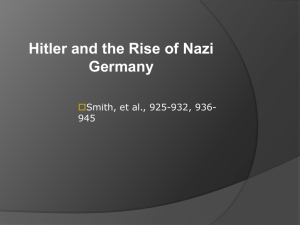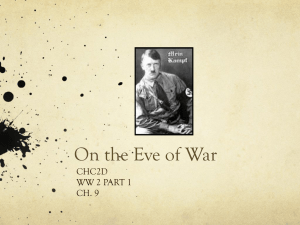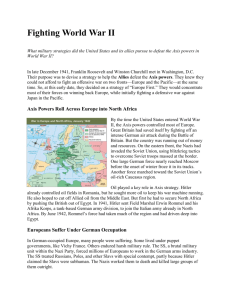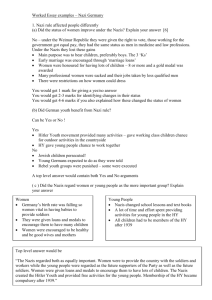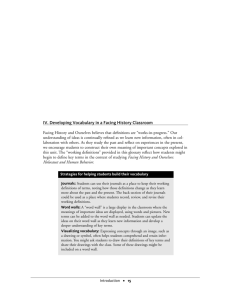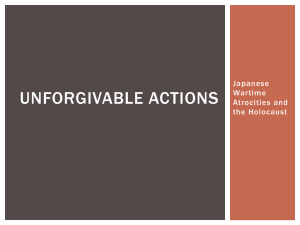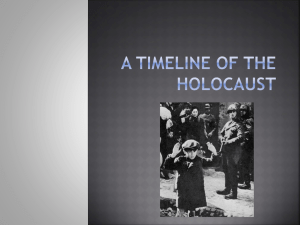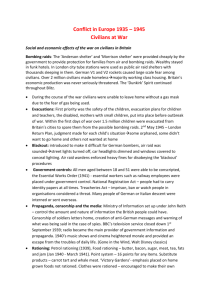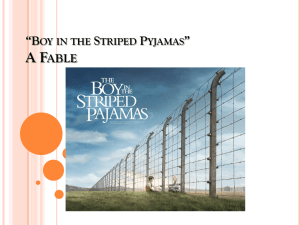Holocaust Timeline Handout
advertisement
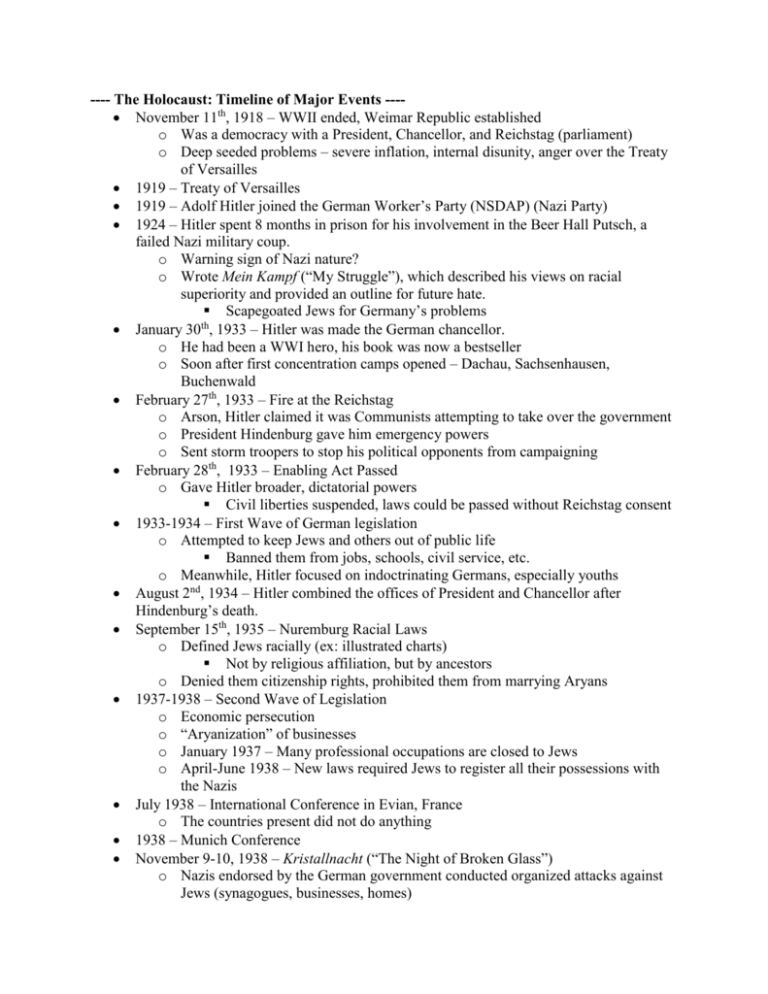
---- The Holocaust: Timeline of Major Events --- November 11th, 1918 – WWII ended, Weimar Republic established o Was a democracy with a President, Chancellor, and Reichstag (parliament) o Deep seeded problems – severe inflation, internal disunity, anger over the Treaty of Versailles 1919 – Treaty of Versailles 1919 – Adolf Hitler joined the German Worker’s Party (NSDAP) (Nazi Party) 1924 – Hitler spent 8 months in prison for his involvement in the Beer Hall Putsch, a failed Nazi military coup. o Warning sign of Nazi nature? o Wrote Mein Kampf (“My Struggle”), which described his views on racial superiority and provided an outline for future hate. Scapegoated Jews for Germany’s problems th January 30 , 1933 – Hitler was made the German chancellor. o He had been a WWI hero, his book was now a bestseller o Soon after first concentration camps opened – Dachau, Sachsenhausen, Buchenwald February 27th, 1933 – Fire at the Reichstag o Arson, Hitler claimed it was Communists attempting to take over the government o President Hindenburg gave him emergency powers o Sent storm troopers to stop his political opponents from campaigning February 28th, 1933 – Enabling Act Passed o Gave Hitler broader, dictatorial powers Civil liberties suspended, laws could be passed without Reichstag consent 1933-1934 – First Wave of German legislation o Attempted to keep Jews and others out of public life Banned them from jobs, schools, civil service, etc. o Meanwhile, Hitler focused on indoctrinating Germans, especially youths August 2nd, 1934 – Hitler combined the offices of President and Chancellor after Hindenburg’s death. September 15th, 1935 – Nuremburg Racial Laws o Defined Jews racially (ex: illustrated charts) Not by religious affiliation, but by ancestors o Denied them citizenship rights, prohibited them from marrying Aryans 1937-1938 – Second Wave of Legislation o Economic persecution o “Aryanization” of businesses o January 1937 – Many professional occupations are closed to Jews o April-June 1938 – New laws required Jews to register all their possessions with the Nazis July 1938 – International Conference in Evian, France o The countries present did not do anything 1938 – Munich Conference November 9-10, 1938 – Kristallnacht (“The Night of Broken Glass”) o Nazis endorsed by the German government conducted organized attacks against Jews (synagogues, businesses, homes) o Official reason behind the arracks: a minor German official, Ernst vom Rath, was killed by a Jew o After anti-Jewish regulations were increased dramatically 1939 – Hitler invaded the rest of Czechoslovakia August 13rd, 1939 – Nazi-Soviet Nonaggression Pact September 1939 – WWII began 1939 – Nazi euthanasia program began o Earlier than the Holocaust (mass murdering of Jews) o 70,000 handicapped people of all ages are killed o Convinced parents to bring their disabled children to special clinics where they were actually euthanized o Secret committee to euthanize patients in institutional settings 1939 – All polish Jews began to be forced into ghettos o Closed ghettos – (most common type) surrounded by walls or barbed wire, unsanitary, crowded conditions inside led to deaths and epidemics o Open ghettos – no walls but restrictions on entering and leaving o Destruction ghettos – short-lived ghettos that people were crowded into for only a few weeks before they were shot or deported September-November 1939 – German Jews, Jewish businesses forced to wear the Star of David o When Nazis came to order Jews into concentration camps and ghettos, they were easier to identify September 3rd, 1941 – Nazis at Auschwitz used gas for the first time to kill 600 Soviet POWS and 250 Poles January 20th, 1942 – Wannsee Conference o Nazis revealed the “Final Solution to the Jewish Question” o Called for the elimination of all 11 million European Jews, whom they believed were polluting the Third Reich th July 10 , 1942 – Nazis at Auschwitz began the first medical experiments on prisoners in concentration camps January 19th, 1943 – Gypsies are arrested and ordered to be sent to the concentration camps April, 1943 – Britain and US held the Bermuda Conference discussing the possible rescue of Jewish refugees, although no concrete action is taken April 19th, 1943 – Warsaw Ghetto Uprising o After over a month of fighting, the rebels were finally crushed o Led to other uprisings across Nazi territory, including spiritual uprisings July 20th, – A small group of officers from the German army failed to assassinate Hitler 1944 – US War Refugee Board founded 1945 – Liberations began o January 18th – 1st liberated camp = Warsaw by the Soviets o Nazis tried to prevent liberation by forcing inmates on “death marches” April 30th, 1945 – Hitler committed suicide November 22nd, 1945 – Nuremburg trials began

